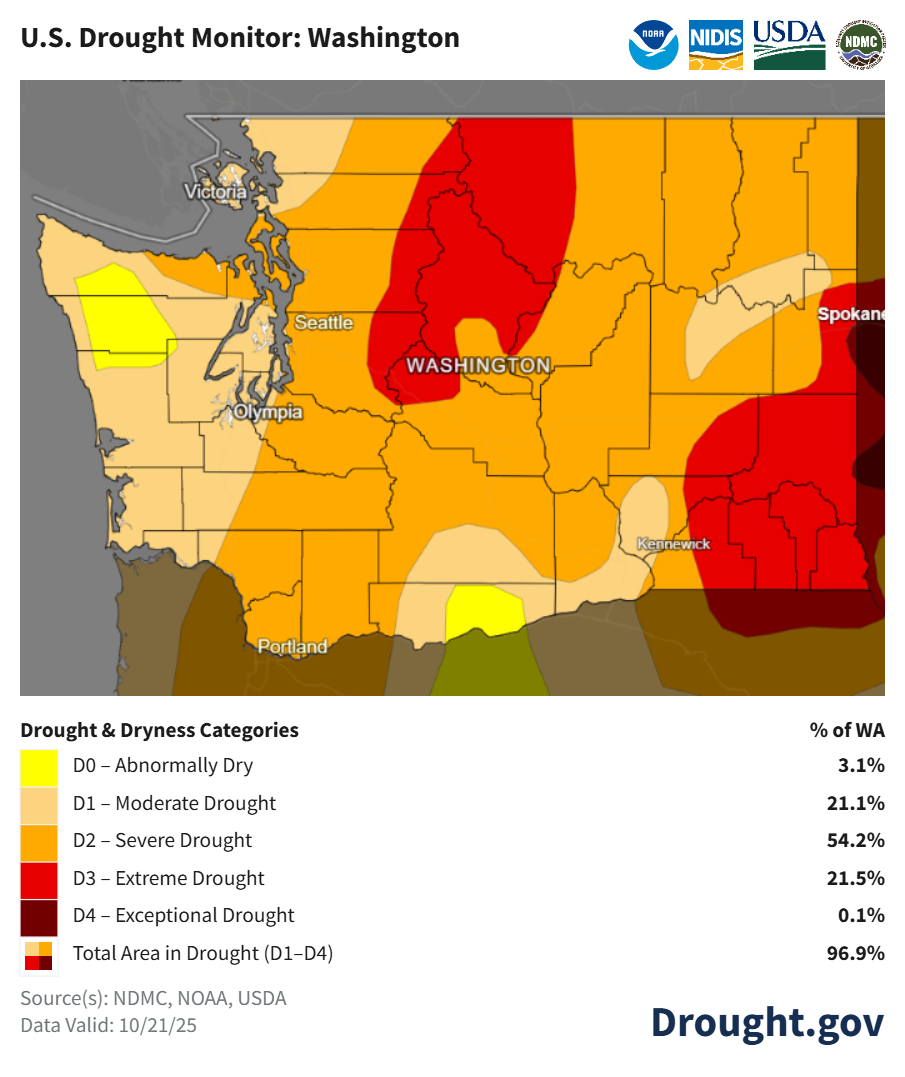Adapting to Drier Times
Washington is In a Multi-Year Drought
In the past three years, Washington State has experienced drought conditions resulting from insufficient water to meet the needs of our state's water users. Drought conditions can result from lack of precipitation, soil moisture anomalies, changes in precipitation patterns, high temperatures, and warmer winters that cause precipitation to fall as rain rather than snow. Currently over 70% of the state is experiencing severe or extreme drought.
Washington 2025 Drought Conditions

The Impacts of Drought
Virtually every aspect of life in Washington is impacted by drought. Water reservoirs can run dry, ski season is shortened, fields produce fewer crops, wildfires are more likely, trees die in greater numbers, fish face disease and famine, and hydropower production is reduced. In October 2025, the Washington Department of Ecology ordered a halt to surface water use from October 6 through the end of the month, as water available from the Yakima Basin reservoirs was expected to run out after October 6.
“We have not experienced a drought like this in over 30 years, and it’s forcing us to take actions we’ve never done before” - Ria Berns, Ecology’s Water Resources program manager
Water diversion restrictions impact agriculture and city drinking water access. Washington water law has a seniority system based on priority dates. When water supplies are low, the most senior rights holders still receive their full amount before junior water rights holders can access theirs. But water supplies have dipped so low that nearly all water rights holders will see their use curtailed. The Yakama Nation holds the most senior water rights, dating back to the Treaty of 1855, which is delivered through the Wapato Irrigation Project, but even that water will have to shut down early as well.
Learn more about the 2025 Yakima Basin Water Restrictions and Drought Conditions from the Washington State Department of Ecology.
What Can You Do?
Taking steps to conserve water will help you save money on your utility bills, and ensure reliable water supplies for the broader community, and help to provide water access for future generations. Savings can be achieved through both the implementation of new technologies and changes in our water usage behaviors.
Saving Water in the Home
In the Bathroom
Over half of all home water usage occurs in the bathroom. There are a few ways you can conserve water in your bathroom:
- Turn off the tap while shaving or brushing teeth.
- Showers use less water than baths, as long as you keep it short.
- Install high efficiency showerheads and toilets.
- Toilets are by far the main source of water use in the home — nearly 30 percent of all indoor residential water consumption.
- Calculate how much you can save with WaterSense labeled products in the bathroom!
In the Kitchen
- Plug up the sink or use a wash basin if washing dishes by hand.
- Use a dishwasher instead of washing by hand.
- Wash only full loads of dishes
- Scrape your plate instead of rinsing it before loading it into the dishwasher.
- Add food wastes to your compost pile instead of using the garbage disposal.
- Do not use water to defrost frozen foods. Thaw foods in the refrigerator overnight.
In the Laundry
- Wash only full loads of laundry or use the appropriate water level or load size selection on the washing machine.
- Consider purchasing a high efficiency washing machine, which can save over 50 percent in laundry water and energy use.
Saving Water Outdoors
In the Yard
Native and drought tolerant plants are a great option for your yard. WSU Cooperative Extension has many resources to assist home gardeners with landscaping using native plants.
Plan your Irrigation:
- Schedule your irrigation for early morning to reduce loss to evaporation.
- Purchase a hose timer to avoid over-watering. Soaker hoses are also a great option for avoiding evaporation.
- Collecting rainwater to use on your landscape can help you save water.
Other Outdoor Uses
- Sweep driveways, sidewalks, and steps rather than hosing off.
- Wash the car with water from a bucket, or consider using a commercial car wash that recycles water.
- If you have a pool, use a cover to reduce evaporation when the pool is not being used. Also, check out the 'Jump into Pool Water Efficiency' guide.
Learn more about water conservation from the EPA and Washington Department of Ecology.

